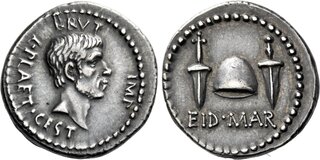| Numismatica Ars Classica > Auction 146 | Auction date: 8 May 2024 |
| Lot number: 2313 Price realized: This lot is for sale in an upcoming auction - Bid on this lot  | Show similar lots on CoinArchives Find similar lots in upcoming auctions on |
| Lot description: Marcus Junius Brutus and L. Plaetorius Caestianus. Denarius, Northern Greece 43-42 BC, AR 19 mm, 3.82 g. BRVT IMP L·PLAET·CEST Bare head of Brutus r. Rev. EID·MAR Pileus between two daggers. Babelon Junia 52 and Plaetoria 13. C 15. Sydenham 1301. Sear Imperators 216. Kent-Hirmer pl. 27, 98. Cahn, EIDibus MARtiis, Q. Tic. 18, 1989, 11b (this coin). Campana, Eidibus Martiis, 37 (this coin). RBW –. Crawford 508/3. Very rare and the finest specimen in private hands of this important and fascinating issue. A wonderful portrait of excellent style perfectly struck on excellent metal on a very large flan. Enchanting old cabinet tone, almost invisible marks, otherwise good extremely fine Ex Naville 2, 1922, Vautier, 37 and Leu 17, 1977, Nicolas, 833 sales. Perhaps no coin of antiquity is as familiar, or as important, as the 'Eid Mar denarius of Brutus: its dagger-flanked liberty cap and explicit inscription are a simple and direct monument of one of the great events in western history. This type is so remarkable that, unlike the anonymous mass of ancient coinage, it elicited commentary from the ancient historian Dio Cassius (XLVII.25). The murder of the dictator Julius Caesar in the Senate House on the Ides of March, 44 B.C., is one of the major turning points in western history. It is impossible to know how the Roman world would have changed had Caesar not been murdered on that day, but the prospect certainly taxes the imagination. Caesar was a populist and an opportunist bent upon dismantling the traditional arrangement of senatorial authority that concentrated power in the hands of the ancient and elite families. In the minds of Brutus and his fellow conspirators, theirs was a struggle to maintain the traditional hold on power, and with that aim they struck down Caesar. This class struggle was couched in the terms of the ancient form of Republican government, and of Rome's hatred for kings and autocrats; thus it is no surprise that the two leaders, Brutus and Cassius, follow the twin-symmetry of the two consuls, and even of Castor and Pollux, the mythical saviours of Rome. The designs on the coin are worth visiting individually, in detail. The reverse testifies to the murder of Caesar by naming the date of the event, by showing daggers as the instruments of delivery, and by displaying the pileus, or freedman's cap, which symbolises the professed goal of the assassins' work. Though dozens of men were involved in the plot against Caesar, all are represented by only two daggers – a clear allusion to Brutus and Cassius as leaders of the coup and, subsequently, of the armed opposition to Antony and Octavian. The portrait is also of great interest and importance. The only securely identifiable portraits of Brutus occur on coins naming him imperator: the Eid Mar denarii of Plaetorius Cestianus and the aurei of Servilius Casca and Pedanius Costa. Indeed, all other portraits on coins or other media are identified based upon these three issues. S. Nodelman has made careful study of the Eid Mar series from the art-historical view, and H. A. Cahn has similarly done so from the numismatic perspective. The former has divided Brutus inscribed coin portraits into three main categories: a 'baroque style portrait on the aurei of Casca, a 'neoclassical style on the aurei of Costa, and a 'realistic style on the Eid Mar denarii of Cestianus. Nodelman describes the Eid Mar portraits as "the soberest and most precise" of all, and he divides them into two distinct categories, 'plastic and linear', suggesting both were derived from the same sculptural prototype. Estimate: 500000 CHF |  |



